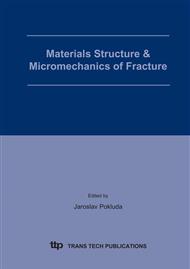[1]
G. Stanfield: Proc. Institution of Mechanical Engineers 131, (1935), p.93.
Google Scholar
[2]
D.F. Socie, G.B. Marquis: Multiaxial Fatigue, (Society of Automotive Engineers, Inc. Warrendale, Pa., 2000), p.484.
Google Scholar
[3]
W.N. Findley: Journal of Engineering for Industry, November (1959), pp.301-306.
Google Scholar
[4]
D.L. McDiarmid: Fatigue Fract. Eng. Mater. Struct., Vol. 14, (1990), pp.429-453.
Google Scholar
[5]
H. Dietmann, T. Bhongbhibhat, A. Schmid: Mechanical Engineering Publications, Eds. K. Kussmaul, D. McDiarmid, and D. Socie, London, (1991), pp.449-469.
Google Scholar
[6]
T. Matake: Bulletin of the JSME, Vol. 20, No 141, (1977), pp.257-26.
Google Scholar
[7]
E. Macha: Scientific papers of the Inst. of Mater. Sc. And Appl. Mech., Wroclaw TU, No 41, Monographs, No 13, Wroclaw (1979), p.99 (in polish).
Google Scholar
[8]
A. Carpinteri, E. Macha, R. Brighenti, A. Spagnoli: Int. J. Fatigue, Vol. 21, 1999, pp.83-96.
Google Scholar
[9]
Macha E.: Mat. -wiss. U. Werkstotech. No. 20, 1989, Teil I, Heft 4/89, pp.132-136, Teil II, Heft 5/89, pp.153-163.
Google Scholar
[10]
I.V. Papadopoulos, P. Davoli, C. Gorla, M. Filippini, A. Bernasconi: Int. J. Fatigue, Vol. 19, (1997), pp.219-235.
Google Scholar
[11]
M.W. Brown, K.J. Miller: Fatigue Eng. Mater. Struct. Vol. 1, (1979), pp.231-246.
Google Scholar
[12]
A. Fatemi, P. Kurath: Trans. ASME J. Eng. Mat. Techn, Vol. 110, (1988), pp.380-388.
Google Scholar
[13]
Macha E.: Fortschr. -Ber. VDI Reihe 18, Nr 52, VDI-Verlag, Dusseldorf 1988, ps 102.
Google Scholar
[14]
K.N. Smith, P. Watson, T.H. Topper: Journal of Materials, Vol. 5, No. 4, (1970), pp.767-778.
Google Scholar
[15]
D.F. Socie: ASME J. Engin. Mat. Techn., Vol. 109, (1987), pp.292-298.
Google Scholar
[16]
T. Ogata, A. Nitta, K. Kuwabara: Third Inter. Conf. On Biaxial/Multiaxial Fatigue, MPA Univ. Stuttgart, Vol. 2, (1989), p.56. 1-56. 17.
Google Scholar
[17]
K.C. Liu: Advances in Multiaxial Fatigue, ASTM STP 1191, Philadelphia, (1993), pp.67-84.
Google Scholar
[18]
G. Glinka, G. Shen, A. Plumtree: Fatigue Fract. Eng. Mater. Struct., Vol. 18, (1995), pp.37-46.
Google Scholar
[19]
T. Łagoda, E. Macha, W. Będkowski: Int. J. Fatigue, Vol. 21, (1999), pp.431-443.
Google Scholar
[20]
X. Chen, S. Xu, D. Huang: Fatigue Fract. Eng. Mater. Struct., Vol. 22, (1999), pp.679-686.
Google Scholar
[21]
J. Hoffmeyer, R. Döring, T. Seeger, M. Vormwald: Elsevier Science, ICF10, (2001), CD, p.8 With the support of the Commission of the European Communities under the FP5, GROWTH Programme, contract No. G1MA-CT2002-04058 (CESTI).
Google Scholar


